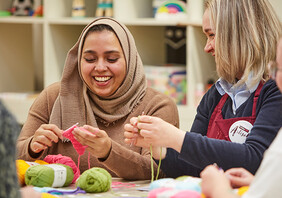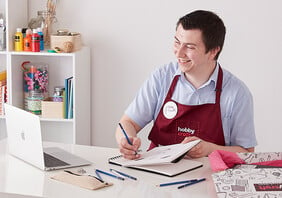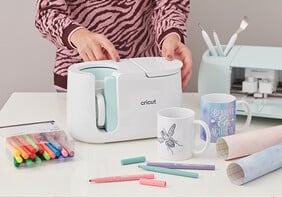4 Spray Paint Projects to Try
Give your home that wow factor with these four spray paint projects. Create a piece of abstract art that's perfect for any space, or upcycle an old accessory, it couldn't be easier with spray paint!
Whether you are a beginner or a seasoned spray painter, these projects will allow you to express yourself and create something truly unique!
You will need
4 Spray Paint Projects to Make
Vase
* Ceramic Vase
* x3 Spray Paints (We've used Montana Shock White, Blue Dark and Baby Blue)
* Carboard/Protective Sheet
* Sandpaper (60 and 100 Grit)
* Disposable Gloves or Old Rubber Gloves
* Face Mask
* Paper Towel or Cloth
Toy
* Gold Spray Paint
* Old Toy
* Carboard/Protective Sheet
* Sandpaper (80 or 100 Grit)
* Disposable Gloves or Old Rubber Gloves
* Face Mask
* Pencil
Frame
* x2 Spray Paints (We've used Montana Blue Velvet and Shock Yellow)
* Gloss Varnish Spray
* Wooden Photo Frame
* Carboard/Protective Sheet
* Sandpaper (80 or 100 Grit)
* Disposable Gloves or Old Rubber Gloves
* Face Mask

In this easy-to-follow project, you will learn how to create a flowing effect by using gravity to trickle down the canvas and merge the colours together.

With a damp cloth or paper towel, wipe down the outside of your vase to remove any dirt or grime.
Then, roughly sand over the entire vase. Vases typically have a glazed finish to them which make it tricky to sand, if the vases still feels smooth after sanding it won’t impact the spraying too much. Ensure all the dust is wiped off the vase before moving onto the next step.



Put on your gloves in preparation for spraying. Before spraying the vase, first shake the can well (in order to mix the paint) and try a test spray on a piece of paper or carboard. Then, place the vase on a small piece of carboard.
Once you are happy that the can is spraying well, begin to slowly spray the baby blue onto the vase. Hold the can between 15 to 20 cm from the vase, and lightly coat the vase with paint. Due to the glazed shiny finish on the vase, spraying from further away will help prevent drips and will produce an even coat.



Holding the scrap piece of carboard, gently rotate to enable you to spray all the sides ensuring to also spray from above on the lip and inside of the vase. This process is worth taking your time with as it will makes later steps easier.
When completed, if you discover drips or bobbles don't worry, most of these will be concealed in later steps. If you are producing a lot of drips, then hold the nozzle further away when spraying.
Leave to dry for approximately 20 minutes, lightly touch an area to check if dry.



Grab the white spray paint, shake well and do a test spray to ensure the colours are correct and the nozzle is functioning properly.
In a small area, spray the white at a closer distance, roughly 10-15 cm away. Whilst the white paint is still wet, scrunch up a small piece of newspaper and lightly dab it onto the white paint. This will reveal the baby blue from the background and create a textured effect.




Continue to work around the vase in small, easy to manage areas using your newspaper to create the texture. Try to press quite lightly with the newspaper to create a more subtle effect. The paint may look a little dry or “sandy” but this is fine, we alter this at a later step.
For easier texturing, put your hand in the vase and rotate it around, this will aid with stability and makes sure the vase doesn’t fall over when texturing.





Now you will use the blue dark spray, ensure you test the spray before use.
Spray directly onto another small piece of scrunched up newspaper and dab onto the vase. Working slowly with small amounts of paint on the newspaper helps control how much of the darker tones to apply to this minimalist design.
One happy with the outside, repeat this process for the lip and inside edge of the vase. This only needs to be done on the very top visible parts and not the deeper inside of the vase.


If you create a pattern that you are unhappy with, we can show you how to reverse and fix this.
Spray over the area that needs altering with the white, then use a fresh piece of newspaper to conceal the area. You can do this as many times as you wish until you find a design that suits you!
Once you are happy, leave the vase to dry for approximately 20 minutes.



Now that the vase is dry, start gently sanding over the entire vase with a fine grit sandpaper. Doing this takes the edge of some of the rough textures and creates a smoother finish.
Take your time with this process, sanding too aggressively may cause chips in the paint. If chips form, again fix this by spraying with the shock white and repeating the newspaper process to conceal.



At this stage the vase will feel and look quite dry and will not look like an authentic glazed finish vase. We will now recreate the glazed look by adding a coat of spray gloss varnish to elevate the colours and make the vase feel smooth.
Begin with a test spray, then lightly spray across the entire vase including the top lip, using the scrap piece of carboard to turn the vase around.
Top Tip: If you are unsure that you have produced an even coat with the varnish, you can use a torch to spot the areas you may have missed.
After 30 minutes, a second coat can be applied for extra protection and to create a smoother finish. The second coat is not essential.






Cut out a small piece of sandpaper and sand down the front and all the sides of the frame, including the inside edge. For the hard-to-reach areas, fold your sandpaper in half and sand following the lines of the frame.
When finished sanding, blow on the frame or use a paper towel to remove any sawdust, this will make sure there is an even coat when spraying.




Put on your gloves in preparation for spraying.
Starting with the blue velvet spray, make sure to shake the can well before use to ensure the paint is mixed and try a test spray onto a piece of paper or carboard. Once happy that the paint is vibrant, you are ready to begin spraying the frame.

Holding the can roughly 10-15cm away, begin to spray the entire frame with the blue velvet in a side-to-side motion.
Top Tip: Use different angles to ensure all areas of the frame are covered and remember to spray the outside edge and inside edge of the frame. This may require you to hold the can closer to the frame as they can be hard to reach.



Repeating step 3, test the yellow can before spraying directly onto the frame. This step can be started when the blue velvet is still wet, but if it's dry it doesn’t matter.
Spray in one of the corners with short bursts by tapping the nozzle. Taking your time with this step helps control where the paint goes to achieve the desired effect.
Using different angles again helps get better coverage and a fuller, sharper colour.




Repeat step 5 on the opposite corner of your frame to create an opposite pattern. Don’t worry if one corner is slightly different compared to the other one, as the later steps will mask this slightly; imperfections add character and interest!



Now for the messy part! Spray onto the middle finger of your non dominant hand holding the nozzle very close (but not touching). A “pool” of paint will form on your finger ready to create flicks. Immediately after you have sprayed onto your finger, before the paint dries flick the yellow onto the frame in a direction of your choosing.
Repeat this step a few times in both corners of the frame. The amount of flicks you add is down to personal preference, so when happy, move onto the next step.




Repeating Step 7, with your index finger (or with a new pair of gloves if preferred), follow the same process of spraying, now with the blue velvet.
Make sure to flick onto the large yellow areas as much as you desire. This helps bring the painting and colours together.




Wait for roughly 30 minutes for the frame to be touch dry, and then apply a thin coat of the varnish. If a gloss finish is preferred, adding a coat of gloss spray varnish will help achieve a bright, shiny layer to the frame. If you prefer a matt finish, you can skip this step or follow this step with the matt spray varnish (this will add a layer of protection to your frame but is not essential).





In the hard-to-reach places, use a pencil and wrap some sandpaper around it, this will help sand the harder to reach places. Also, you can fold the sandpaper in half to get in the hardest places (such as behind the ears and tail etc).
Wipe off any residue from the sanding with your hand or a paper towel.




Put on your gloves in preparation for spraying. Before straying the object, first shake the can well (in order to mix the paint), and try a test spray on a piece of paper or carboard.
Once happy that the paint is vibrant, you are ready to begin spraying.

Hold the top of the toy and begin to spray the underside first. Starting this way helps to spray the hardest to reach places first, and makes the rest of the painting easier.
Holding the can roughly 10cm away from the toy, spray in short bursts rather than holding the nozzle fully down. Spraying with the nozzle too close can make the paint drip on the surface and make it uneven, so starting further away to begin is a useful tip!



Next, flip over the toy and place it on the protected surface ready to spray the top side.
Using different angles, repeat the same process as the underside, spraying to achieve a smooth finish. Be aware of your surrounding when spraying at different angles and try not to spray into yourself.
Top Tip: Rotating the protected surface can make it easier to spray.



Once you are happy with your coverage, you can leave the toy to dry (60 minutess touch dry and 12-24 hours fully cured).
If you have missed some areas when spraying, you can apply a second coat following the same steps as before. If your first coat has left some visible drips or imperfections, you can lightly sand the drips out and begin again. The beauty of spray painting is you can always cover mistakes!


There, you've given an old toy a new lease of life and it's perfect for styling on a shelf or mantel piece!






